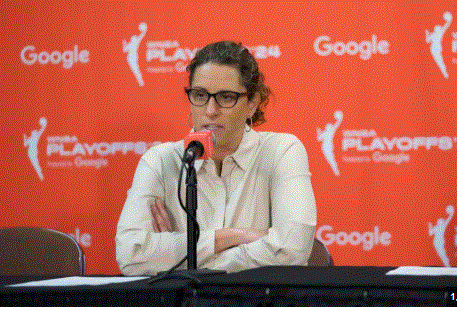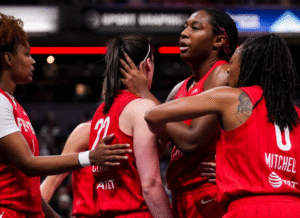
1. Introduction to the Big Announcement
In a thrilling development for the Indiana Fever organization, a significant announcement has stirred excitement and anticipation within the WNBA community. Caitlin Clark, the beloved guard entering her second season with the Fever, has been named one of the team captains for the upcoming WNBA All-Star Game. This designation adds a major accolade early in her professional career and reinforces her rising status in the league.

2. The All-Star Game Framework
Every summer, the WNBA showcases its brightest talents in the All-Star Game, a mid-season exhibition featuring stand-out players from the Eastern and Western Conferences. This year’s competition is scheduled for July 19 and will take place in Indianapolis, a city with strong basketball roots and a rich history of hosting major sporting events. Not only is the location significant—bringing the event to Indiana—but also the spotlight on local talent represents a special moment for fans and players alike.
3. Caitlin Clark as Eastern Conference Captain
Caitlin Clark will lead the Eastern Conference squad as one of the official team captains. This role is not just honorary: captains choose their rosters, provide leadership, and represent their conference throughout the event’s weekend festivities. For Clark—only in her second professional season—being entrusted with this responsibility signals her rapid ascent in league prominence. It marks her second consecutive All-Star selection, affirming that her impact and popularity extend well beyond her rookie breakthrough.
4. Western Conference Captains Highlight the Cutthroat Competition
Meanwhile, on the other side of the court, Napheesa Collier of the Minnesota Lynx has been named captain for the Western Conference All-Star team. Collier’s selection injects even more starpower into the event, ensuring that both teams will feature plenty of elite talent. The showdown between Clark and Collier on All-Star weekend sets the stage for competitive gameplay and friendly rivalry.
5. What This Means for Indiana Fever and Fans
Indiana Fever supporters are understandably thrilled by the news. The Fever organization and its players wasted no time in celebrating Clark’s recognition. Social media channels buzzed with excitement following the announcement, proving the depth of support and admiration fans have for the rising star. The team’s official accounts not only confirmed her captaincy but also emphasized her status as a repeated All-Star, highlighting the narrative of her meteoric rise.
6. Player Reactions: Embracing the Moment
Fever players themselves were quick to extend their congratulations. Aliyah Boston, now playing alongside Clark in her third year, shared her enthusiasm exclaiming, “Yassssss.” Her message reflected both genuine pride and the camaraderie among teammates—a bond strengthened in their shared journey with Indiana. The team’s social media also joined in, captioning Clark simply but emphatically: “Captain CC.” This camaraderie keeps the fan base deeply engaged and emotionally invested in each milestone.
7. The Dynamic Duo: Boston and Clark
Boston and Clark find themselves in their second season playing together with Indiana. Both players broke out in the previous year: Clark as a rookie sensation, Boston as a dominant forward. Their chemistry has been integral to the team’s collective success. During last season’s All-Star Game, the duo represented Team East alongside guard Kelsey Mitchell. This continued collaboration indicates the growing core of young talent within the franchise.
8. A Recap of Last Season’s Success
Indiana delivered a commendable 20–20 record last season—clinching a postseason berth in the fiercely competitive Eastern Conference. That achievement owed much to the leadership and productivity of Clark, Boston, and Mitchell. Together, they elevated the Fever’s play and helped deepen interest in the franchise’s trajectory. Though the team ultimately fell to the Connecticut Sun in the first round of the playoffs, the campaign was still considered a victory for building momentum.
9. Boston’s Ongoing Progress in Year Three
In her third professional season, Aliyah Boston continues to assert herself as one of the WNBA’s premier forwards. She’s consistently contributed strong all-around numbers, averaging approximately 15.9 points, 8.2 rebounds, and 3.6 assists per game. That level of performance not only makes Boston a defensive and offensive anchor for Indiana, but also keeps her among the league’s top-tier talents—frequently putting her in All-Star conversations herself.
10. Clark’s All-Around Excellence
Meanwhile, Caitlin Clark remains central to the Fever’s plans as their floor general, dynamic scorer, and playmaker. Her sophomore season statistics reflect her comprehensive impact: an average of 18.2 points, 5 rebounds, and a remarkable 8.9 assists per game. Such numbers—particularly the assist figure—highlight her rare blend of scoring prowess and playmaking vision. Her presence alone shapes how opponents approach defending the Fever.
11. Recent Absence Due to Injury
However, not every part of Clark’s story has headed upward in recent weeks. She’s missed the last two Fever games due to a groin injury. While any sideline absence for a star player gives fans concern, her captaincy announcement indicates that her overall status remains strong. There’s hope she’ll soon return in time to follow through on her All-Star duties and continue her streak of appearances.
—
Putting It All Together: Themes and Significance
A. Rapid Rise and Recognition
From college sensation to professional star, Clark’s journey has been strikingly swift. Within just two WNBA seasons, she has been named captain of an All-Star team and holds consecutive All-Star selections. That trajectory highlights not just her ability and dedication, but also the league’s embrace and endorsement of her as a central figure moving forward.
B. Elevation of the Indiana Fever
Clark’s status boosts the Fever’s visibility at a national level. Add to that the rising profile of teammates like Boston and Mitchell, and the franchise appears jet-propelled into relevance. Their collective youth, talent, and chemistry underpin a growing culture of competitiveness and have fans—and the league—even projecting greater postseason ambitions.
C. Star Power and WNBA Growth
Clark’s captaincy spotlights larger league dynamics, as the WNBA continues expanding its fanbase and broadcast footprint. Having an electrifying rookie-turned-rookie sensation at the forefront fuels media attention, sponsorship interest, ticket sales, and ratings. All-Star games themselves serve as both celebration and promotion, and Clark’s role exemplifies the WNBA’s rising star trend.
D. Local Pride and Home Advantage
Hosting the All-Star Game in Indianapolis adds another layer of resonance. It brings Clark’s hometown area fanbase together and infuses the event with regional pride. For young Hoosiers who watched her rise through college, her presence is a full-circle moment. For Fever fans, it’s a showcase—and potentially a launching pad—for deeper connection with their spirited wing.
E. What’s Ahead for Indiana
The Fever remain in building mode. After missing games with Clark’s injury, the team is poised for reintegration once she recovers. They will look to improve on last season’s .500 record and make a deeper playoff run. If Boston continues to build on her stellar consistency and Clark remains healthy and engaged, the Fever have a legitimate chance to ascend into legitimate Eastern Conference contenders.
—
Deep Dive: Player Profiles
Caitlin Clark – The Torso of a Modern WNBA Offense
Clark’s ascent began at the University of Iowa, where her three-point shooting and playmaking abilities turned her into a national name. In the pros, she’s maintained that brand of offense. With around 18.2 points per game early in her second season, she’s already approaching elite scoring tiers. Her 8.9 assists per game signify her vision and ability to elevate teammates—metrics that position her among the top playmakers in the league.
Her captaincy reflects more than raw numbers. She’s also become a cultural phenomenon—logos on jerseys, viral shots, endless highlight reels, plus waves of mainstream attention. That cultural capital matters; it drives media narratives, social engagement, and brand value. Clark is turning into a foundational figure in the WNBA renaissance.
Aliyah Boston – Two-Way Force and Franchise Builder
Boston’s career trajectory also earns respect. In her third season, she’s averaging close to 16 points and over eight rebounds per outing, with a healthy chunk of assists per game. Those stats reflect her keystone presence in the paint, ability to stretch offensively, and defensive dominance.
Her earlier All-Star co-appearance with Clark showed the team’s growing core. As her third season progresses, Boston continues to assert herself as a multi-positional player who can shift momentum on either end. The Fever’s defensive identity often begins with her.
Napheesa Collier – Western Conference Stalwart
Collier’s selection as Western Conference captain injects solidity to the other side of the All-Star pairing. A multi-year standout with the Minnesota Lynx, she’s renowned for her versatility, grit, and ability to contribute across rebounds, scoring, and defense.
Her appointment mirrors Clark’s vis-à-vis star-power alignment and anchor identity. All-Star fan anticipation will include watching these two leaders—Clark for the East, Collier for the West—determine rosters, draft teams, and lead during the weekend’s skill competitions and exhibition plays.
—
The All-Star Game’s Role and Implications
Function & Format
The WNBA All-Star Game, typically held mid-July, combines a main exhibition matchup, skill contests, and fan engagement promotions. Captains draft teams either from a pool of fan-voted starters and coach-selected reserves or through some hybrid selection mechanism. The draft dynamic adds narrative interest, with each captain forming bonds and rivalries with teammates and competitors.
Fan Experience & Visibility
Hosting the event in Indianapolis—a basketball-crazy city, and within Indiana Fever territory—augments local enthusiasm. Team promotions, school outreach, clinics, and pop-up fan events typically surround the All-Star festivities. That grassroots surge can enhance ticket sales, broadcast attention, and lasting fandom.
Market Impact
With marquee names like Clark attached, media attention intensifies. Journalists, analysts, and social influencers examine the narrative arcs: rookie phenom continuing her streak, Vanquish rival candidates, comparisons with earlier WNBA legends, and the league’s strategy of player-focused marketing models. Expect deeper coverage across ESPN, Bleacher Report, The Athletic, and regional sports networks—putting the Fever and Indianapolis moment front and center.
—
Last Season’s Foundation and Future Outlook
2024 Season Recap
The Fever’s .500 finish and postseason appearance marked a turning point after several absent playoff years. Their first-round loss to Connecticut might’ve been disappointing, but it provided a foundation of progress and hope. Clark and Boston’s development, alongside veteran guard Kelsey Mitchell, gave life to a projected rebuild that skipped typical growing pains.
2025 Trajectory
Entering this second season with Clark, third with Boston, plus other roster adjustments, the Fever appear positioned not just for a plateau, but for an actual ascent. Their Eastern Conference competition includes juggernauts like New York Liberty, Chicago Sky, and Connecticut Sun. But Indiana’s young core, growing chemistry, and increased national profile—even markable by Clark’s All-Star captaincy—create the potential for them to swing the balance.
Challenges Ahead
Key challenges include maintaining Clark’s health—her groin injury is concerning, though she’s on track for return—with Boston keeping up her consistency. The team must climb from average to heavyweight, winning more games, improving playoff seeding, and gaining experience on the big stage. Coaching, roster depth, and in-game adjustments will determine whether they transform from “dark horse” into real contention.
Conclusion: Peak Moment for the Fever and WNBA Storytelling
Caitlin Clark’s selection as Eastern Conference captain isn’t just a personal achievement; it’s validation of the Fever’s rebuild, of her global traction, and of the league’s strategy to spotlight star-building narratives. Assisted by teammates like Aliyah Boston—herself an ascending power—and held up by institutional support, the Fever have the makings of a revitalized franchise.
As they prepare for All-Star weekend in Indianapolis, anticipation builds around Clark’s return from injury, her performance alongside other elites, and her drafting of a competitive Team East. Across the WNBA, the event becomes another stepping stone in its growth arc—Leaning on young stars, marketing momentum, and fan engagement to push the league into a new era of prominence.
When the buzzer sounds on July 19, all eyes—on Clark, Boston, Collier, and the All-Star showcase—will be on Indiana. From rookie stardom to conference captaincy in only two seasons, Clark’s rising story arc exemplifies WNBA expansion, and her presence in her home-state city embodies that connection between player, franchise, and fans—a peak moment for Fever history, the sport’s marketing evolution, and league trajectory.
Leave a Reply